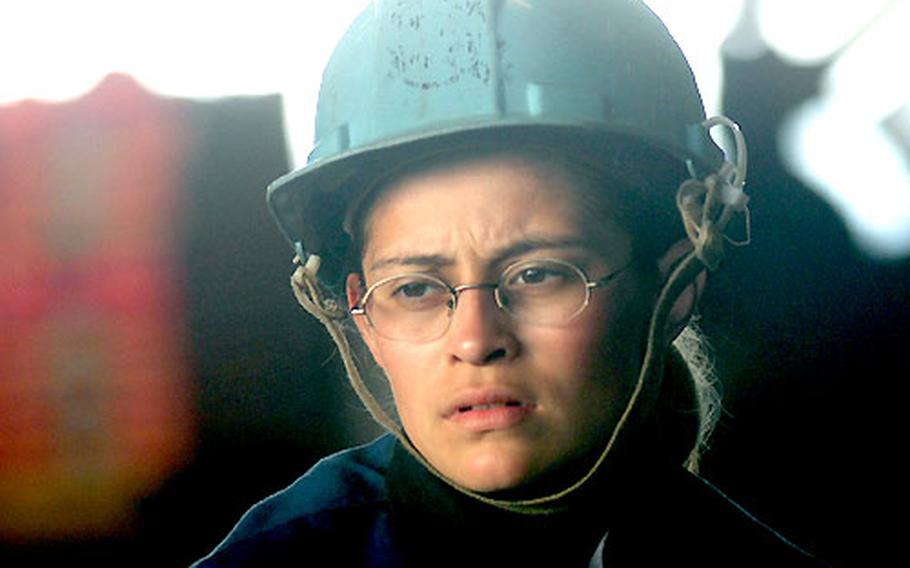
Seaman Jenny Loaiza concentrates as she holds the telephone line during an underway replenishment, (Kendra Helmer / Stars and Stripes)
ABOARD THE USS KITTY HAWK — Petty Officer 3rd Class Rodney Mayes sees himself as the conductor of a symphony.
Near him, Seaman Apprentice Derick Clemmson sees himself as a loser in a tug-of-war game.
The two sailors on the USS Kitty Hawk are part of the deck department team, whose nearly 90 members help get fuel for the ship and its hungry crew.
At least twice a week, the aircraft carrier ties up to other ships for underway replenishments in the northern Persian Gulf. Last week, the USNS Pecos simultaneously refueled the Kitty Hawk and another Yokosuka, Japan-based ship, the USS Cowpens. The USNS Niagara Falls delivered food and supplies a day later.
“Everything’s almost the same except what you’re getting,” said Senior Chief Petty Officer Elvis Buckhalter, 38, describing the similarities of the two types of replenishments.
As the deck department’s leading chief petty officer, Buckhalter helps oversee the show.
First up is a gunner who fires a shot line to the replenishing ship. Its sailors connect the line to a messenger line and send it back across.
On the messenger line are the tools for the replenishment: a phone line and line for the fuel probe (or cable for a trolley for cargo movements).
“All this stuff can’t happen without the shot line making it over there,” said a gunner, Airman Erik Dawson, 23.
After everything is set up, Clemmson’s tug-of-war game begins. At the carrier’s open hangar doors, he and a few line handlers grasp the 200-foot phone line strung between the two ships so the crews can communicate. The line handlers pull on the half-inch thick line if the ships drift together, and slack it if the ships move apart.
About 20 feet away are the riggers, four at each station. During underway refuelings, they wait for snakelike fuel hoses to come over and then hook the probe to other hoses and a pipe leading below deck.
On Friday, nearly 700,000 pounds of diesel and 400,000 pounds of fuel were received.
During supply replenishments, they assemble the rig that brings over the cargo. As the cargo clears the deck, the riggers steady it and make sure it lands safely.
Seaman Nathan Robinson, 21, said that while a lot of the work involves waiting for fuel to finish pumping or cargo to cross between ships, “it’s exciting; there’s a slight element of danger to it, especially in high seas.”
Overseeing some of the riggers for just the fourth time Saturday was Mayes, grinning about his job during breaks between his rig captain training.
“You’re supposed to have your eyes open and be a conductor of a symphony and tell them what to do and make sure that no one gets hurt,” said Mayes, 20. “You’re in charge of everything … bringing over the probe, the cargo.”
Sailors on the other ship hook the cargo to a trolley attached to the wire.
After it slides to the carrier, a sailor lowers it. Mayes yells, “Riggers in!” and it is released. The trolley lifts up and the gear heads back to the replenishment ship. It takes between two and eight minutes for the trolley to complete a round trip.
Also swarming about the flight deck are safety officers such as Petty Officer 2nd Class Matthew Kotch, 23, a boatswain’s mate.
They mainly watch UIs — short for sailors under instruction — and stand ready to jump in if something doesn’t look right. A hospital corpsman also stands ready.
“I make sure no one’s going to get hurt and try to see what’s going to happen before it happens,” Kotch said.
Accidents are rare, but the occasional wire snaps. It’s especially tricky during high seas.
While the deck department normally steers the ship, during underway replenishments, it’s the job of a navigation department master helmsmen to keep the ship on a straight course, said Petty Officer 1st Class James Hancock, 32, a quartermaster who has been driving ships for 12 years.
While part of the crew works through the process, others just enjoy the show.
Petty Officer 2nd Class Brad Hosley, 22, said he’s gone to the forward lookout hundreds of times to watch.
“It’s awesome how they can keep them perfectly straight alongside each other,” he said. “I never get tired of watching it.”